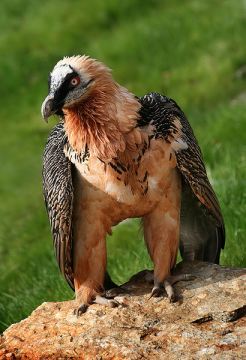Today is International Vulture Awareness Day. Always a fan of the underdog, I jump at the chance to talk about these birds, so for the past two years, I’ve featured Canada’s only vulture species- the Turkey Vulture. This year I decided to reprise an article I did on one of my other blogs about some unique bird behaviour in the vulture world.
In the high mountains of southern Europe, Africa, India and Tibet lives a large bird that exists on a diet of bone.
The lammergeier, or bearded vulture, eats almost exclusively the bones of dead animals – up to 90% of their diet is bone. They are the only vertebrate in the world with this diet, and their extremely acid stomach allows them to digest entire bones overnight.
This huge bird is 95-125 cm (37-49″) long with a 235-280 cm (91-110″) wingspan. Like other members of the vulture family, the lammergeier is a clean-up master.
They soar across vast areas to locate animal carcasses and skeletons. When gathered around an animal carcass, lammergeiers must wait until other species have eaten their fill. Unlike other vultures, these birds have feathered heads and do not dig deep into the carcass. They have to make do with the leftovers, and as a result have developed the specialty of bone-eating.
If the bones are too big to eat at the kill site, the vulture picks them up in his talons and flies to a favored bone-breaking site, when he either cracks them against a passing rock, or drops them onto the rocky surface. This bone-breaking action can be carried out as often as 30 times before the bones are small enough to digest.
Once the bone has shattered, their narrow, pointed tongue is an excellent adaptation for extracting the highly nutritious bone marrow. Lammergeiers weigh between 5 and 7 kg (11 and 15 lbs), and eat about a tenth of their body weight in bone every day.
As if a diet of 90% bone and bone marrow wasn’t unusual enough, researchers in Spain have found these birds select the bones with the most fat. Their study of bones left behind versus those taken, and the use of monitoring cameras set up at nest sites, determined the bones left had significantly less fat than those taken. Even in the nest, they sifted through the pile and took the richest bones with the most fat. These specialist birds extract about 13,000 calories per bite-sized serving, which provides plenty of energy for soaring over huge areas.
For an occasional change of diet, live tortoises are also dropped onto rocks to crack them open.
The Greek playwright Aeschylus was said to have been killed in 456 or 455 BC by a tortoise dropped by an eagle who mistook his bald head for a rock. This was thought to be a myth until someone sighted a bearded vulture dropping a tortoise from height onto rocks. If this incident did occur, the lammergeier must be a likely candidate for the “eagle”.
For a specialist eater, I’d say they’ve got the market cornered. It’s not like there’s a line up of other birds wanting to steal their yummy greasy bones.
More information on International Vulture Awareness Day




